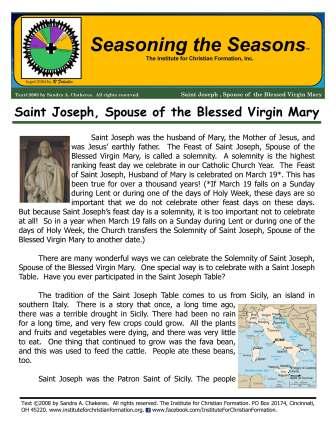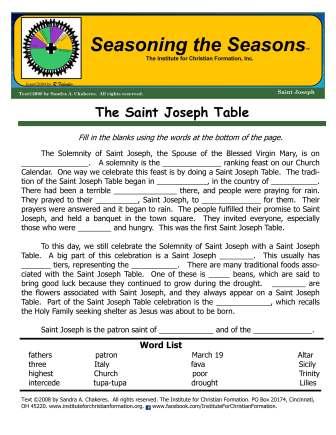The Institute for Christian Formation
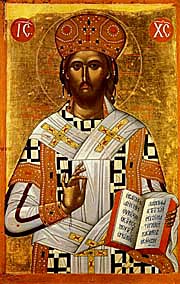
Saint Joseph
March 19: Solemnity of Saint Joseph,
Spouse of the Blessed Virgin Mary
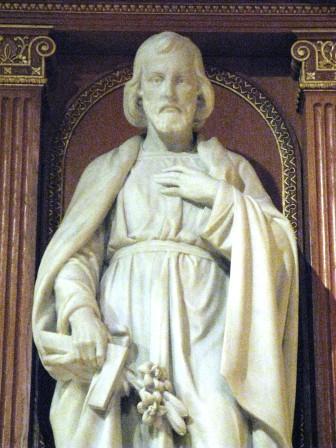
Saint Joseph was the husband of Mary, the Mother of Jesus, and was Jesus’ earthly father. The Feast of Saint Joseph, Spouse of the Blessed Virgin Mary, is a solemnity. A solemnity is the highest ranking feast day we celebrate in our Catholic Church Year. The Feast of Saint Joseph, Husband of Mary is celebrated on March 19*. This has been true for over a thousand years. (*If March 19 falls on a Sunday during Lent or during one of the days of Holy Week, these days are so important that we do not celebrate other feast days on these days. But because Saint Joseph’s feast day is a solemnity, it is too important not to celebrate at all! So in a year when March 19 falls on a Sunday during Lent or during one of the days of Holy Week, the Church transfers the Solemnity of Saint
Joseph, Spouse of the Blessed Virgin Mary to another date.)
There are many wonderful ways we can celebrate the Solemnity of Saint Joseph, Spouse of the Blessed Virgin Mary. One special way is to celebrate with a Saint Joseph Table.
The tradition of the Saint Joseph Table comes to us from Sicily, an island in southern Italy. There is a story that once, a long time ago, there was a terrible drought in Sicily. There had been no rain for a long time, and very few crops could grow. All the plants and fruits and vegetables were dying, and there was very little to eat. One thing that continued to grow was the fava bean, and this was used to feed the cattle. People ate these beans, too.
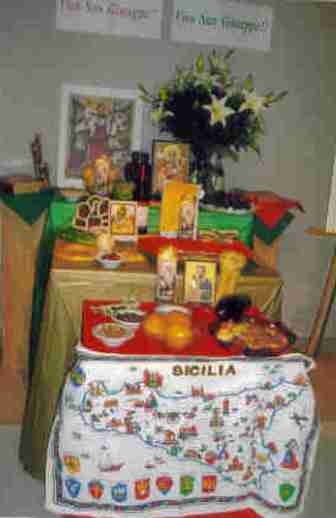
Saint Joseph was the Patron Saint of Sicily. The people began to pray to Saint Joseph, asking Saint Joseph to intercede for a miracle – that they would have rain. In their prayer, the people promised Saint Joseph that if it rained, and their crops grew, they would gather their harvest and have a huge banquet in the town center. They would invite everyone to come – especially those who were very poor and hungry.
The prayers of the people were answered. It began to rain! The people kept their promise to Saint Joseph. On March 19, Saint Joseph’s Feast Day, the people of Sicily hosted a large banquet in the town square. They had many good things to eat. They had fruit and vegetables, pasta, bread and wine, cakes, pastries, and dishes made
with fava beans. They also had many kinds of fish and seafood. Being an island, seafood was plentiful. But the one thing they didn’t have at their banquet was meat. Meat was not plentiful in Sicily, plus it was the season of Lent, and at that time people ate no meat at all during Lent.
Everyone attended the banquet. The poor and hungry were especially happy to be there. Because this banquet was done to fulfill a promise the people had made to Saint Joseph, the banquet was called a Saint Joseph Table. After that, every year on the Feast of Saint Joseph, Spouse of the Blessed Virgin Mary, the people would do a Saint Joseph Table. The four-minute video below has excellent images of a traditional Feast of Saint Joseph as celebrated in Cianciana – Agrigento - Sicily, with photos by Agostino D'Ascoli.
After several hundred years, some people from Sicily came to America. Here in the United States they continued their tradition of the Saint Joseph Table. Grandparents taught their children and grandchildren about this tradition.
Today, we still celebrate the tradition of the Saint Joseph Table. Sometimes a family or several families come together and open up their home to host a Saint Joseph Table. Sometimes a parish community hosts a Saint Joseph Table. Everyone is invited to the Saint Joseph Table. It is especially important that those people who might be hungry or lonely are invited to share our food and companionship.
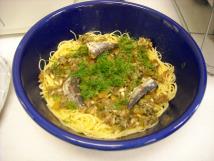
The foods we eat at the Saint Joseph Table are traditional foods from Sicily. There are special recipes made with fish, and pasta, and fava beans, and fruits and vegetables that grow in Sicily. There are traditional breads and pastries served. In fact, there is even special bread called Saint Joseph Bread. Sometimes this bread is baked in special shapes to remind us of Saint Joseph. It might be baked in the shape of Saint Joseph’ s beard, or his
staff. There are even bread crumbs served to put on the pasta. The bread crumbs look a little bit like saw dust – don’t forget that Saint Joseph was a carpenter by trade!
At the Saint Joseph Table celebration, there is also a special Saint Joseph Altar set up and decorated. This is often a three-tiered altar to remind us of the Holy Trinity. Sometimes the altar is so big that all the food is put on it! There is usually an icon or statue of Saint Joseph on the altar. And there are flowers –
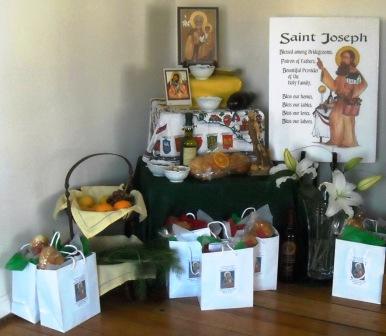
always including lilies. Often in religious art, Saint Joseph is depicted holding a lily.
Sometimes the fruits and vegetables and other items are arranged on the Saint Joseph Altar in a significant way. There are lemons and oranges and grapes, and there are fava beans and fennel and olives and artichokes and eggplants – all sorts of wonderful foods that are grown in Sicily. You might find seven lemons on a plate
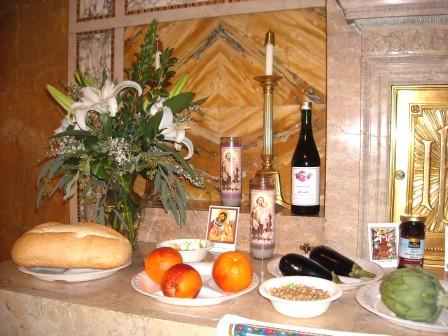
symbolizing the seven sacraments. Perhaps you will find twelve whole fish reminding us of the twelve apostles.
And there are special “altar ornaments” decorating the altar. These aren’t made to be eaten, but are like the cookie-dough ornaments you may make at Christmas. These ornaments might be shaped like the carpenter’s tools Saint Joseph might have used. Or they might be religious symbols, like a dove for the Holy Spirit, or a cross. Sometimes these ornaments are decorated with a special paste made from figs, another food that grows in Sicily.
At the Saint Joseph Table celebration, something else special happens. This is called the “Tupa Tupa.” In Italian, Tupa means knock. Children or teens dress up like Joseph and Mary. They might have a doll, or even a real baby or toddler, who represents Jesus. Then the Holy Family tries to come to the celebration. Saint Joseph knocks on the door, and someone asks who he is and what he wants. He responds that he is Saint Joseph and he is looking for shelter for himself and Mary and Jesus. Usually he is turned away the first time, and has to knock two more times until the Holy Family is invited in. This reminds us of when Mary was getting ready to give birth to Jesus and Saint Joseph was trying to find a place for them to stay. Luke’s Gospel tells us that Jesus was born in a manger, because there was no room in the inn.
The ten-minute video below is a beautiful visual celebration of the celebration of the Feast of Saint Joseph in Salemi, Sicily in 2010.
Sometimes everyone at the Saint Joseph Table gets a “goodie bag” to take home. The goodie bag might contain some of the following: a piece of blessed Saint Joseph Bread, a blessed fava bean (it is said that fava beans are lucky since they continued to grow during the drought in Sicily), a Saint Joseph medal or holy card, a prayer to Saint Joseph, and maybe even an orange to remind us of the sweetness of Saint Joseph!
Saint Joseph is the Patron Saint of many people and places, including fathers and the universal Church! Every day when you pray, ask Saint Joseph to watch over all fathers and to guide our Church. Saint Joseph will intercede for us, just as he did for the people of Sicily when they had their drought! Saint Joseph, pray for us!
Resources for Celebrating the Solemnity of Saint Joseph and hosting a Saint Joseph Table Celebration:
Here is a link to some traditional Saint Joseph Table Recipes. Savuer has a recipe for Saint Joseph Bread, and even has instructions for shaping the bread into Saint Joseph’s Staff. If you are not a baker, sometimes you can even order Saint Joseph Bread online!
Here is one source for prayer to Saint Joseph, and here is another. You can purchase Saint Joseph Greeting Cards from The Printery House, and Bridge Building Images is another source for Saint Joseph Holy Cards, Prayer Cards, and Icons. If you are looking for a Saint Joseph coloring page, here is one source. You can even decorate your Saint Joseph Altar with a decorative tea towel of Sicily.
There are also several good books available about Saint Joseph’s Feast Day. “The Little Jesus of Sicily” by Fortunato Pasqualino and translated by Louise Rozier is a fictional work which describes the day when a child is chosen to be Jesus for the traditional Saint Joseph Feast Day celebration. “St. Joseph Altars” by Kerri McCafferty gives information about the history and tradition of the Saint Joseph Altar, and includes many beautiful photos of Saint Joseph Altars, as well as traditional recipes. “The Saint Joseph Day Table’s Cookbook” by Mary Ann Giordano with Paul Giordano, M.D., is an entire cookbook dedicated to Saint Joseph Feast Day recipes and traditions.
Click on the image above to download our ICF story about The Feast of Saint Joseph and the Saint Joseph Table Tradition.
Click on the image above to download our ICF Saint Joseph Table Fill-in-the-Blank activity sheet.
Click on the image above to download our ICF Saint Joseph Scripture Search, to find out what the Bible tells us about Saint Joseph.
Click on the image above to download our ICF Saint Joseph Altar Activity Sheet.
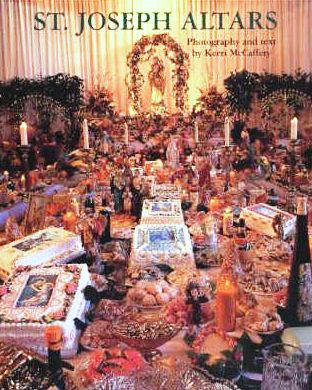
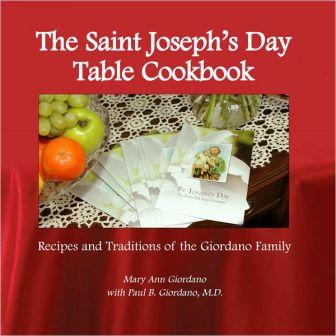

Celebrate Saint Joseph’s Feast Day this year, whether with your own family or your entire parish and neighborhood!
VIVA SAN GIUSEPPE !
